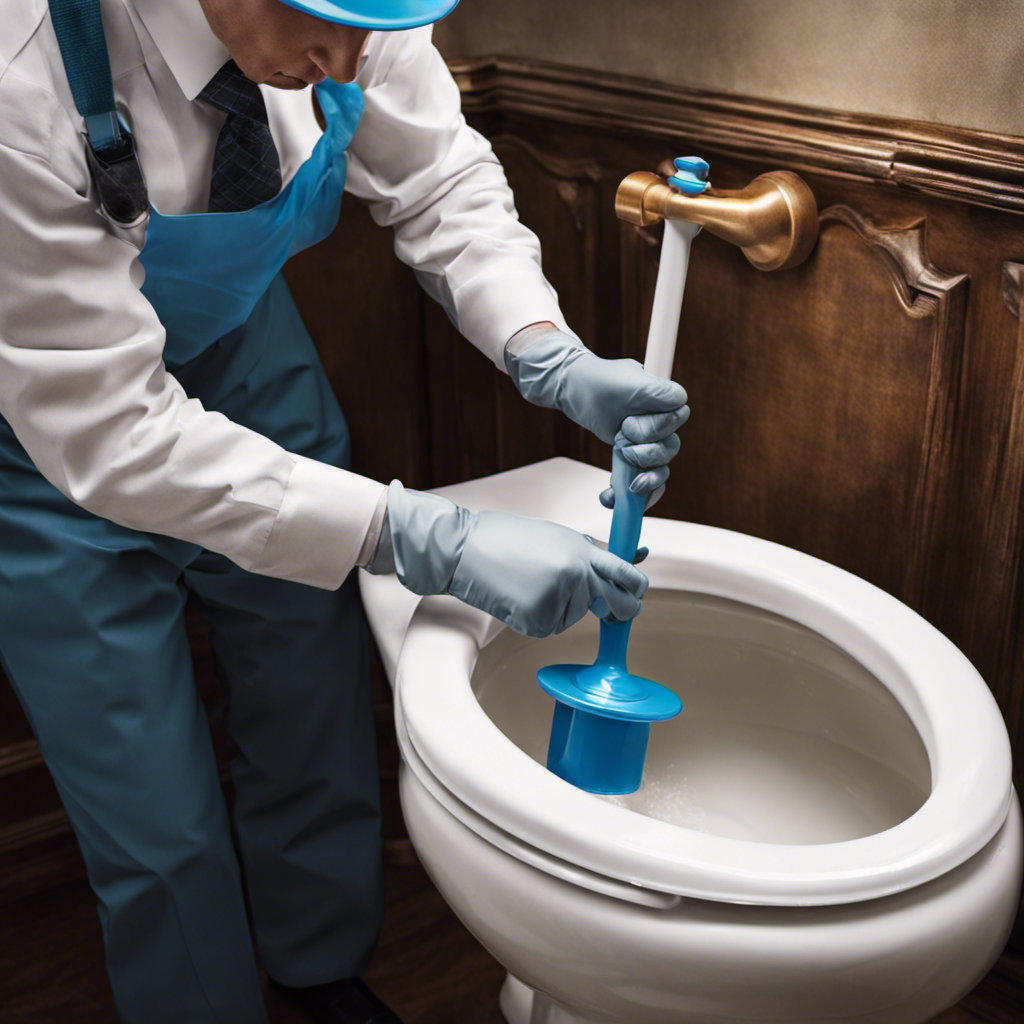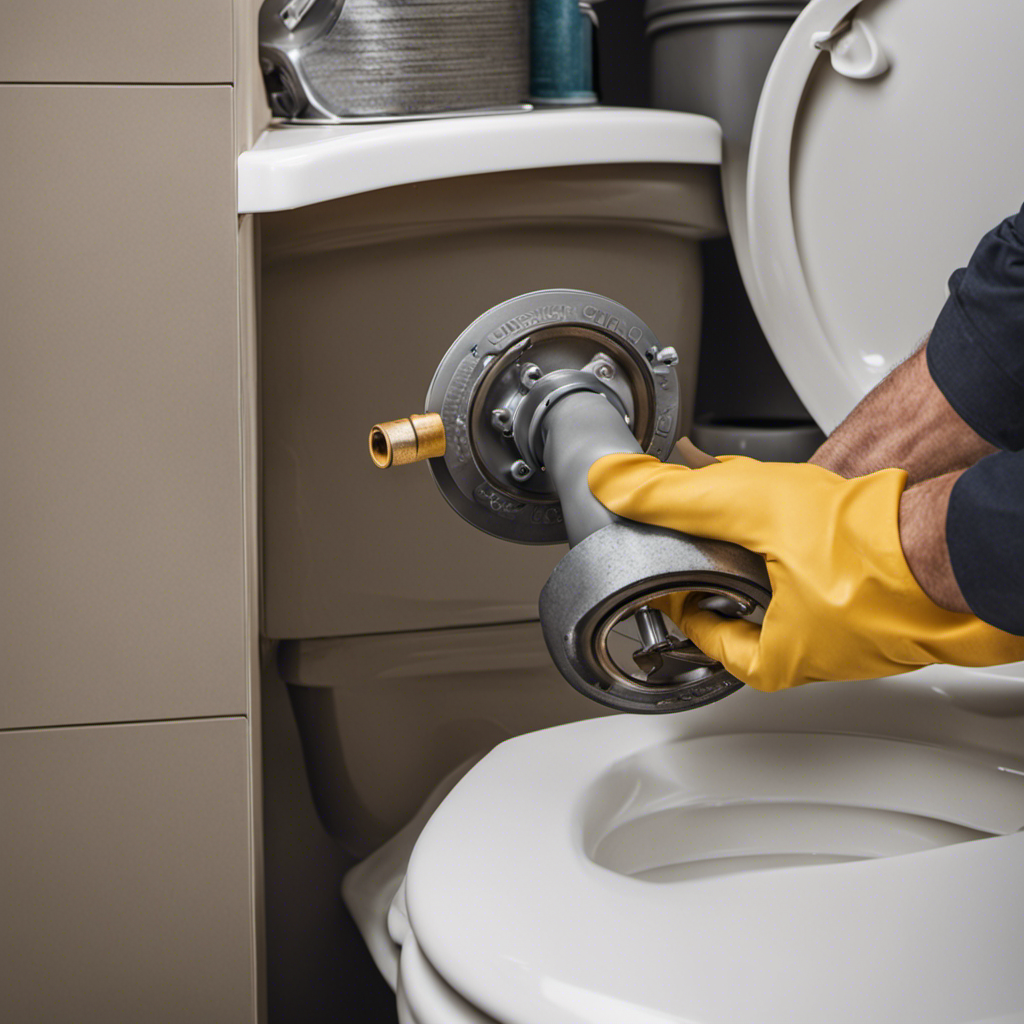Oh great, another day, another household problem to solve.
But this time, it’s not just any problem – it’s a toilet leaking from the bottom!
And let me tell you, there’s nothing more frustrating than dealing with a leaky toilet.
Lucky for you, I’ve got all the knowledge and expertise to help you fix this pesky issue.
So, buckle up and get ready to say goodbye to that annoying drip-drip-drip once and for all.
Key Takeaways
- Common causes of toilet leaks from the bottom include a faulty or worn out wax ring, loose toilet bolts, a cracked or leaking toilet tank, and faulty or damaged toilet parts.
- To identify the source of the leak, check the water supply line for cracks or loose connections, inspect the wax ring seal for gaps or deterioration, look for water pooling around the base of the toilet, and check for signs of moisture or a constantly running toilet.
- Fixing a leaking wax ring involves turning off the water supply and draining the toilet, removing the toilet by disconnecting the water supply line and bolts, scraping off the old wax ring and cleaning the flange, placing a new wax ring on the flange with proper alignment, and reattaching the toilet and tightening the bolts.
- Replacing faulty toilet bolts is important to improve toilet stability and prevent water leakage from the base. It is recommended to install new, high-quality bolts to extend the lifespan of the toilet.
Common Causes of Toilet Leaks From the Bottom
One of the most common reasons for a toilet leaking from the bottom is a faulty wax ring. The wax ring is a seal that sits between the toilet base and the flange, preventing water from leaking out. Over time, the wax ring can become worn out or damaged, causing water to seep through.
To prevent future toilet leaks, regular toilet maintenance is essential. First, check the condition of the wax ring and replace it if necessary. Additionally, ensure that the toilet bolts are tightened securely and not loose. Regularly inspect the toilet tank for any cracks or leaks, and replace any faulty parts promptly.
By following these toilet maintenance tips, you can prevent future leaks and maintain the integrity of your toilet.
Now, let’s move on to identifying the source of the leak.
Identifying the Source of the Leak
To identify where the leak is coming from, you should check the water supply line and the wax ring seal. Signs of a hidden toilet leak include a constantly running toilet or water pooling around the base.
If you suspect a leak, it’s important to act quickly to prevent further damage. Start by inspecting the water supply line, which connects the toilet tank to the water source. Look for any cracks, loose connections, or signs of moisture.
Next, examine the wax ring seal, located between the toilet base and the floor. Check for any gaps or deterioration in the wax ring. If you spot any issues, you can try DIY methods to temporarily fix the leaking toilet, such as tightening connections or replacing the wax ring seal.
However, it’s recommended to consult a professional plumber for a permanent solution.
Fixing a Leaking Wax Ring
Inspect the wax ring seal for any gaps or signs of deterioration before attempting to fix the leaking toilet. The wax ring is a crucial component that creates a watertight seal between the toilet flange and the base of the toilet. Over time, the wax ring can wear out or become damaged, leading to leaks. To fix this issue, you will need to replace the wax ring.
Before doing so, make sure to turn off the water supply and drain the toilet. Then, remove the toilet by disconnecting the water supply line and the bolts securing it to the floor. Once the toilet is removed, scrape off the old wax ring and clean the flange thoroughly. Place a new wax ring on the flange, making sure it is properly aligned. Finally, reattach the toilet and tighten the bolts. This should solve the leaking problem and ensure a proper seal.
To further troubleshoot leaks, it is important to inspect the toilet flange. The toilet flange is the piece that connects the toilet to the floor and also serves as a support for the toilet. If the flange is damaged or improperly installed, it can cause leaks. Check for any cracks, breaks, or corrosion on the flange. If any issues are found, the flange may need to be replaced. Additionally, ensure that the flange is securely fastened to the floor. Loose or improperly secured flanges can also lead to leaks.
Replacing Faulty Toilet Bolts
Check if you need to replace the faulty bolts by examining their condition and stability. Here are four reasons why replacing toilet bolts is crucial for a successful DIY toilet repair:
-
Safety: Faulty bolts can cause the toilet to become unstable, leading to potential accidents and injuries.
-
Leak prevention: Loose or damaged bolts can result in water leakage from the base of the toilet, causing damage to your bathroom floor and increasing your water bill.
-
Improved toilet stability: Replacing faulty bolts ensures that your toilet remains securely fastened to the floor, preventing any wobbling or movement.
-
Longevity: Installing new, high-quality bolts can extend the lifespan of your toilet, preventing the need for frequent repairs and replacements.
Professional Solutions for Persistent Leaks
If you’re experiencing persistent leaks despite addressing the issue of faulty bolts, it might be worth considering professional solutions.
While replacing faulty bolts can often fix toilet leaks, there are cases where the problem persists. In such situations, effective sealants for toilet leaks can provide a more reliable solution.
Professional plumbers have access to high-quality sealants that are specifically designed to create a watertight seal and prevent leaks from occurring. These sealants are often made of durable materials that can withstand the constant exposure to water and the pressure of flushing.
Additionally, professionals can also provide valuable advice on preventing future toilet leaks, such as regular maintenance, proper installation, and using quality components.
Hiring a professional can save you time, money, and the frustration of dealing with persistent leaks.
Frequently Asked Questions
How Can I Prevent a Toilet Leak From Happening in the First Place?
To prevent a toilet leak, I recommend taking preventative measures such as regular maintenance, checking for cracks or loose fittings, and ensuring proper installation. Common causes include worn-out seals, faulty supply lines, or a loose flange.
Can a Leaking Wax Ring Cause Damage to the Flooring or Subfloor?
A leaking wax ring can potentially cause damage to the flooring or subfloor. Signs of a leaking wax ring include water pooling around the base of the toilet and a foul odor.
Are There Any Temporary Fixes to Stop a Toilet From Leaking While Waiting for a Professional Plumber?
There are a few temporary fixes for a leaking toilet. Common causes include a faulty flapper or a loose connection. To stop the leak temporarily, you can try adjusting the flapper or tightening the connections.
Should I Attempt to Fix a Leaking Wax Ring Myself, or Is It Better to Hire a Professional?
I’m weighing the pros and cons of DIY toilet repairs versus hiring a professional plumber. It’s important to consider the complexity of the issue and the potential risks involved before attempting any repairs myself.
If the Toilet Bolts Are Loose, Is It Necessary to Replace Them or Can They Be Tightened?
If the toilet bolts are loose, it’s important to tighten them to prevent leaks. Replacing them may not be necessary unless they are damaged. Think of it like tightening a loose screw to secure a structure.
Conclusion
In conclusion, dealing with a leaking toilet can be a messy and inconvenient ordeal. However, by understanding the common causes and taking appropriate action, such as fixing a leaking wax ring or replacing faulty toilet bolts, you can put an end to the problem.
If the issue persists, it’s advisable to seek professional solutions. Remember, addressing this situation promptly will ensure a more pleasant and hygienic bathroom experience.
So, don’t let a little leak dampen your day, take the necessary steps to fix it!










